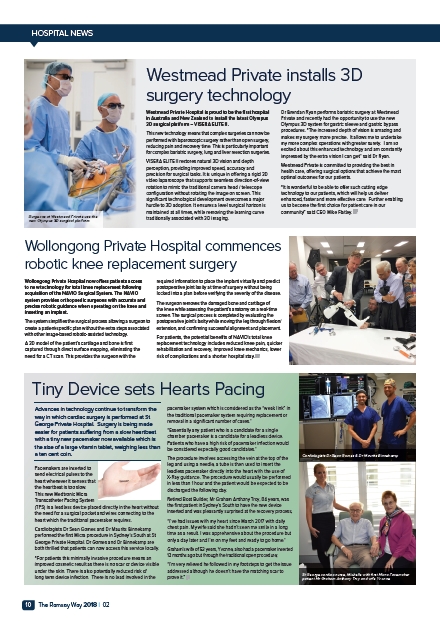
HOSPITAL NEWS Westmead Private installs 3D
Wollongong Private Hospital commences
robotic knee replacement surgery
10 The Ramsay Way 2018 | 02 Tiny Device sets Hearts Pacing
Advances in technology continue to transform the
way in which cardiac surgery is performed at St
George Private Hospital. Surgery is being made
easier for patients suffering from a slow heartbeat
with a tiny new pacemaker now available which is
the size of a large vitamin tablet, weighing less than
a ten cent coin.
Pacemakers are inserted to
send electrical pulses to the
heart whenever it senses that
the heartbeat is too slow.
This new Medtronic Micra
Transcatheter Pacing System
(TPS) is a leadless device placed directly in the heart without
the need for a surgical pocket and wires connecting to the
heart which the traditional pacemaker requires.
Cardiologists Dr Sean Gomes and Dr Maurits Binnekamp
performed the first Micra procedure in Sydney‘s South at St
George Private Hospital. Dr Gomes and Dr Binnekamp are
both thrilled that patients can now access this service locally.
“For patients this minimally invasive procedure means an
improved cosmetic result as there is no scar or device visible
under the skin. There is also potentially reduced risk of
long term device infection. There is no lead involved in the
pacemaker system which is considered as the “weak link” in
the traditional pacemaker system requiring replacement or
removal in a significant number of cases.”
“Essentially any patient who is a candidate for a single
chamber pacemaker is a candidate for a leadless device.
Patients who have a high risk of pacemaker infection would
be considered especially good candidates.”
The procedure involves accessing the vein at the top of the
leg and using a needle, a tube is then used to insert the
leadless pacemaker directly into the heart with the use of
X-Ray guidance. The procedure would usually be performed
in less than 1 hour and the patient would be expected to be
discharged the following day.
Retired Boat Builder, Mr Graham Anthony Troy, 84 years, was
the first patient in Sydney’s South to have the new device
inserted and was pleasantly surprised at the recovery process;
“I’ve had issues with my heart since March 2017 with daily
chest pain. My wife said she hadn’t seen me smile in a long
time as a result. I was apprehensive about the procedure but
only a day later and I’m on my feet and ready to go home.”
Graham’s wife of 53 years, Yvonne, also had a pacemaker inserted
12 months ago but through the traditional open procedure;
“I’m very relieved he followed in my footsteps to get the issue
addressed although he doesn’t have the matching scar to
prove it.”
Cardiologists Dr Sean Gomes & Dr Maurits Binnekamp
St George cardiac nurse, Michelle with first Micra Pacemaker
patient Mr Graham Anthony Troy and wife Yvonne
surgery technology
Westmead Private Hospital is proud to be the first hospital
in Australia and New Zealand to install the latest Olympus
3D surgical platform – VISERA ELITE II.
This new technology means that complex surgeries can now be
performed with laparoscopic surgery rather than open surgery,
reducing pain and recovery time. This is particularly important
for complex bariatric surgery, lung and liver resection surgeries.
VISERA ELITE II restores natural 3D vision and depth
perception, providing improved speed, accuracy and
precision for surgical tasks. It is unique in offering a rigid 3D
video laparoscope that supports seamless direction-of-view
rotation to mimic the traditional camera head / telescope
configuration without rotating the image on screen. This
significant technological development overcomes a major
hurdle to 3D adoption. It ensures a level surgical horizon is
maintained at all times, while removing the learning curve
traditionally associated with 3D imaging.
Dr Brendan Ryan performs bariatric surgery at Westmead
Private and recently had the opportunity to use the new
Olympus 3D system for gastric sleeve and gastric bypass
procedures. “The increased depth of vision is amazing and
makes my surgery more precise. It allows me to undertake
my more complex operations with greater surety. I am so
excited about this enhanced technology and am constantly
impressed by the extra vision I can get” said Dr Ryan.
Westmead Private is committed to providing the best in
health care, offering surgical options that achieve the most
optimal outcomes for our patients.
“It is wonderful to be able to offer such cutting edge
technology to our patients, which will help us deliver
enhanced, faster and more effective care. Further enabling
us to become the first choice for patient care in our
community” said CEO Mike Flatley.
Wollongong Private Hospital now offers patients access
to new technology for total knee replacement following
acquisition of the NAVIO Surgical System. The NAVIO
system provides orthopaedic surgeons with accurate and
precise robotic guidance when operating on the knee and
inserting an implant.
The system simplifies the surgical process allowing a surgeon to
create a patient-specific plan without the extra steps associated
with other image-based robotic-assisted technology.
A 3D model of the patient’s cartilage and bone is first
captured through direct surface mapping, eliminating the
need for a CT scan. This provides the surgeon with the
required information to place the implant virtually and predict
postoperative joint laxity at time of surgery without being
locked into a plan before verifying the severity of the disease.
The surgeon removes the damaged bone and cartilage of
the knee while assessing the patient’s anatomy on a real-time
screen. The surgical process is completed by evaluating the
postoperative joint’s laxity while moving the leg through flexion/
extension, and confirming successful alignment and placement.
For patients, the potential benefits of NAVIO’s total knee
replacement technology includes reduced knee pain, quicker
rehabilitation and recovery, improved knee mechanics, lower
risk of complications and a shorter hospital stay.
Surgeons at Westmead Private use the
new Olympus 3D surgical platform